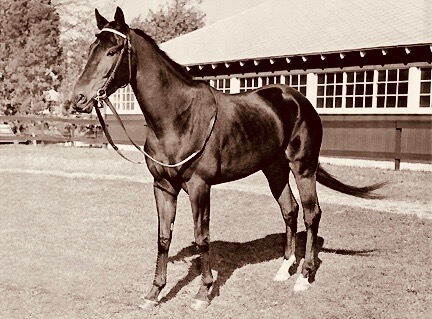
From ancient Rome to contemporary Britain, horse races have attracted enthusiastic audiences. In this article, we’ll take a look at the fastest horses in the history of racing.
5 Best Race Horses of All Time
The Fastest Horses in the History of Racing
1. Kincsem
Possibly the most famous horse in history after Alexander the Great’s Bucephalus, Kincsem (“My Precious”) can be found at the top of many rankings of historic racehorses. Kincsem was a Hungarian Thoroughbred who recorded the most wins out of any undefeated racehorse in history, which puts her at the top of a short list of the most elite famous racehorses. She was foaled in 1874 and started racing two years later. She went on to win 54 races, ending her career undefeated.
Kincsem won classic races in the Austro-Hungarian Empire as well as major-stakes victories in Germany, France, and England. She ran her last race in 1879 in her native country of Hungary. During her career, she became legendary for winning the Goodwood Cup, the Grand Prix de Deauville, and the Grosser Preis von Baden in 1878. She became a point of national pride in her home country and still is to this day.
Kincsem was, without a doubt, one of the best racehorses of all time, her name permanently etched in the annals of history.
Country: Hungary
Foaled: 1874
Races won: 54/54
Estimated earnings: 379,805 German Goldmarks (about $9.74 million 2020 dollars)
2. Black Caviar
Black Caviar is another very successful Thoroughbred who went undefeated in her career. While Kincsem had 54 victories, Black Caviar won 25/25 of its starts, taking second place among history’s top Thoroughbreds.
She was foaled in 2006 in Nagambie, Victoria, Australia. Black Caviar was sired by Bel Esprit, a one-time winner of Australia’s Doomben 10,000. Like many of the best racehorses ever, Black Caviar had a high Timeform rating – 136 in the first quarter of 2011.
This mare ran an undefeated sprinter career from 2009 to 2013. Black Caviar was named the International Federation of Horseracing Authorities World Thoroughbred Racehorse Rankings champion springer four years in a row (2010-2013). She mostly participated in Australian races, running only one race abroad – the UK’s Royal Ascot Diamond Jubilee Stakes, which she won in 2012.
Even though she raced almost exclusively in Australia, Black Caviar gained worldwide recognition. She was named the European Champion Sprinter in 2012. A year later, Black Caviar was added to the Australian Hall of Fame, cementing her place in horse racing history. To read more go to the link below:
https://betblokes.com/blog/fastest-horses-in-history/
Secretariat: Horse Racing
ESPN documentary on legendary, world record breaking race horse – Secretariat. Secretariat (March 30, 1970 — October 4, 1989) was an American Thoroughbred racehorse that in 1973 became the first U.S. Triple Crown champion in 25 years. He set race records in all three events in the Series — the Kentucky Derby (1:59 2/5), the Preakness Stakes (1:53), and the Belmont Stakes (2:24) — records that still stand today. He is considered to be one of the greatest Thoroughbreds of all time. In 1999, ESPN ranked Secretariat the 35th best athlete of the 20th century, the highest ranking racehorse on the list. He ranked second behind Man o’ War in The Blood-Horse’s List of the Top 100 U.S. Racehorses of the 20th Century.
Secretariat was sired by Bold Ruler out of Somethingroyal, by Princequillo. He was foaled at The Meadow in Caroline County, Virginia. Like his famous predecessor Man o’ War, Secretariat was a large chestnut colt and was given the same nickname, “Big Red.” Secretariat’s grandsire, Nasrullah, is also the great-great-grandsire of 1977 Triple Crown winner Seattle Slew.
Owned by Penny Chenery, he was trained by Lucien Laurin and mainly ridden by Canadian jockey Ron Turcotte, along with apprentice jockey Paul Feliciano (first two races), and veteran Eddie Maple (last race). He raced in Chenery’s Meadow Stable’s blue and white checkered colors and his groom was Eddie Sweat. Secretariat stood approximately 16.2 hands (66 inches, 168 cm) tall, and weighed 1,175 pounds (533 kg), with a 75-inch girth, in his racing prime.
History
Riderless Racers at Rome by Théodore Géricault.
Horse racing has a long and distinguished history and has been practised in civilisations across the world since ancient times. Archaeological records indicate that horse racing occurred in Ancient Greece, Babylon, Syria, and Egypt. It also plays an important part of myth and legend, such as the contest between the steeds of the god Odin and the giant Hrungnir in Norse mythology.
Chariot racing was one of the most popular ancient Greek, Roman and Byzantine sports. Both chariot and mounted horse racing were events in the ancient Greek Olympics by 648 BC and were important in the other Panhellenic Games. This was despite the fact that chariot racing was often dangerous to both driver and horse as they frequently suffered serious injury and even death. In the Roman Empire, chariot and mounted horse racing were major industries. And from the mid-15th century until 1882, spring carnival in Rome closed with a horse race. Fifteen to 20 riderless horses, originally imported from the Barbary Coast of North Africa, ran the length of the Via del Corso, a long, straight city street, in about 2½ minutes.
In later times, Thoroughbred racing was, and is, popular with the aristocrats and royalty of British society, earning it the title “Sport of Kings.”
Historically, equestrians honed their skills through games and races. Equestrian sports provided entertainment for crowds and honed the excellent horsemanship that was needed in battle. Horse racing of all types evolved from impromptu competitions between riders or drivers. All forms of competition, requiring demanding and specialized skills from both horse and rider, resulted in the systematic development of specialized breeds and equipment for each sport. The popularity of equestrian sports through the centuries has resulted in the preservation of skills that would otherwise have disappeared after horses stopped being used in combat.
Types of horse racing
There are many different types of horse racing, including:
- Flat racing, where horses gallop directly between two points around a straight or oval track.
- Jump racing, or Jumps racing, also known as Steeplechasing or, in the UK and Ireland, National Hunt racing, where horses race over obstacles.
- Harness racing, where horses trot or pace while pulling a driver in a sulky.
- Endurance racing, where horses travel across country over extreme distances, generally ranging from 25 to 100 miles (40 to 161 km)
Different breeds of horses have developed that excel in each of the specific disciplines. Breeds that are used for flat racing include the Thoroughbred, Quarter Horse, Arabian, Paint, and Appaloosa. Jump racing breeds include the Thoroughbred and AQPS. Harness racing is dominated by Standardbred horses in Australia, New Zealand and North America, but several other breeds, such as the Russian Trotter and Finnhorse, are seen in Europe.
Flat racing is the most common form of racing, seen worldwide. Flat racing tracks are typically oval in shape and are generally level, although in Great Britain and Ireland there is much greater variation, including figure of eight tracks like Windsor, and tracks with often severe gradients and changes of camber, such as Epsom Racecourse. Track surfaces vary with turf most common worldwide, dirt more common in North America, and newly designed synthetic surfaces, such as Polytrack or Tapeta, seen at some tracks worldwide.
Individual flat races are run over distances ranging from 440 yards (400 m) up to two and a half miles, with distances between five and twelve furlongs being most common. Short races are generally referred to as “sprints”, while longer races are known as “routes” in the US or “staying races” in Europe. Although fast acceleration (“a turn of foot”) is usually required to win either type of race, in general sprints are seen as a test of speed, while long distance races are seen as a test of stamina. The most prestigious flat races in the world, such as the Prix de l’Arc de Triomphe, Japan Cup, Epsom Derby, Kentucky Derby and Dubai World Cup are run over distances in the middle of this range and are seen as tests of both speed and stamina to some extent.
In the most prestigious races, horses are generally allocated the same weight to carry for fairness, with allowances given to younger horses and female horses running against males. These races are called conditions races and offer the biggest purses. There is another category of races called handicap races where each horse is assigned a different weight to carry based on its ability. Beside the weight they carry, a horse’s performance can also influenced by its position relative to the inside barrier (post position), its gender, its jockey, and its trainer.
Jump Racing – National Hunt Racing, Steeplechasing and Hurdling (horse race)
Jump (or jumps) racing in Great Britain and Ireland is known as National Hunt racing (although, confusingly, National Hunt racing also includes flat races taking place at jumps meetings; these are known as National Hunt flat races). Jump racing can be subdivided into steeplechasing and hurdling, according to the type and size of obstacles being jumped. The word “Steeplechasing” can also refer collectively to any type of jump race in certain racing jurisdictions, particularly in the United States.
Typically, horses progress to bigger obstacles and longer distances as they get older, so that a European jumps horse will tend to start in National Hunt flat races as a juvenile, move on to hurdling after a year or so, and then, if thought capable, move on to steeplechasing.
The length of an endurance race varies greatly. Some are very short, only ten miles, while others can be up to one hundred miles. There are a few races that are even longer than one hundred miles and last multiple days. These different lengths of races are divided into five categories: pleasure rides (10–20 miles), non-competitive trail rides (21–27 miles), competitive trail rides (20–45 miles), progressive trail rides (25–60 miles), and endurance rides (40–100 miles in one day, up to 250 miles (400 km) in multiple days). Because each race is very long, trails of natural terrain are generally used.
Contemporary organized Endurance racing began in California around 1955, and the first race marked the beginning of the Tevis Cup This race was a one-hundred-mile, one-day-long ride starting in Squaw Valley, Placer County, and ending in Auburn. Founded in 1972, the American Endurance Ride Conference was the United States’ first national endurance riding association. The longest endurance race in the world is the Mongol Derby, which is 833.2 km (517.7 mi) long.
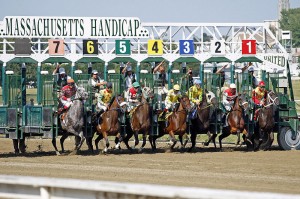 Breeds – Horse Breeding.
Breeds – Horse Breeding.
In most horse races, entry is restricted to certain breeds; that is, the horse must have a sire (father) and a dam (mother) who are purebred individuals of whatever breed is racing. For example, in a normal harness race, the horse’s sire and dam must both be pure Standardbreds. The only exception to this is in Quarter Horse racing where an Appendixed Quarter Horse may be considered eligible to race against (standard) Quarter Horses. An appendixed Quarter Horse is a horse who has either one Quarter Horse parent and one parent of any other eligible breed (such as Thoroughbred, the most common Appendixed cross), or both parents are registered Appendixed Quarter Horses, or one parent is a Quarter Horse and one parent is an Appendixed Quarter Horse. The designation of “Appendixed” refers to the addendum section, or Appendix, of the Official Quarter Horse registry. AQHA also issues a “Racing Register of Merit” which allows a horse to race on Quarter Horse tracks, but not be considered a Quarter Horse for breeding purposes (unless other requirements are met).
A stallion who has won many races may be put up to stud when he is retired. Artificial insemination and Embryo transfer technology (only allowed in some breeds) has brought changes to the traditions and ease of breeding.
Pedigrees of some stallions are recorded in Weatherbys Stallion Book and pedigrees of recent Stakes race winners can be found on sites such as the-racehorse.com. Thoroughbred pedigrees may be found at Australian Stud Book and Thoroughbred Heritage.
There are three founding sires that almost all Thoroughbreds can trace back to: the Darley Arabian, the Godolphin, and the Byerly Turk, named after their respective owners, Thomas Darley, Lord Godolphin, and Captain Robert Byerly. All were taken to England where they were mated with racing mares. Thoroughbreds range in height, and are measured in hands (a hand being four inches). Some are as small as 15 hands while others are over 17 hands. Thoroughbreds can travel medium distances at fast paces, requiring a balance between speed and endurance.
The Arabian horse was developed by the Bedouin people of the Middle East specifically for stamina over long distances, so they could outrun their enemies. It was not until 1725 that the Arabian was introduced into the United States. Arabians appeared in the United States in colonial times, though were not bred as purebreds until about the time of the Civil War. Until the formation of the Arabian Horse Registry of America in 1908, Arabians were recorded with the Jockey Club in a separate subsection from Thoroughbreds.
They must be able to withstand traveling long distances at a moderate pace. Arabians have an abundance of Type I fibers. Their muscles are able to work for extended periods of time. Also, the muscles of the Arabian are not nearly as massive as those of the Quarter Horse, which allow it to travel longer distances at quicker speeds. The Arabian is primarily used today in endurance racing, but is also raced over traditional race tracks in many countries.
Arabian Horse Racing is governed by IFAHR (The International Federation of Arabian Horse Racing Authorities).
The ancestors of the Quarter Horse were prevalent in America in the early 17th century. These horses were a blend of Colonial Spanish horses crossed English horses that were brought over in the 1700’s. The native horse and the English horse were bred together, resulting in a compact muscular horse. At this time, they were mainly used for chores such as plowing and cattle work. The American Quarter Horse was not recognized as an official breed until the formation of the American Quarter Horse Association in 1940.
In order to be successful in racing, Quarter Horses need to be able to propel themselves forward at extremely fast sprinter speed. The Quarter Horse has much larger hind limb muscles than the Arabian, which make it much less suitable for endurance racing. They also have more Type II-b fibers, which allow the Quarter Horse to accelerate rapidly.
When Quarter Horse racing began, it was very expensive to lay a full mile of track so it was agreed that a straight track of four hundred meters, or one quarter of a mile would be laid instead. It became the standard racing distance for Quarter Horses and inspired their name. With the exception of the longer, 870-yard (800 m) distance contests, Quarter Horse races are run flat out, with the horses running at top speed for the duration. There is less jockeying for position, as turns are rare, and many races end with several contestants grouped together at the wire. The track surface is similar to that of Thoroughbred racing and usually consists of dirt.
Horse breeds and muscle structure
Muscles are just bundles of stringy fibers that are attached to bones by tendons. These bundles have different types of fibers within them and horses have adapted over the years to produce different amounts of these fibers. Type II-b fibers are fast twitch fibers. These fibers allow muscles to contract quickly resulting in a great deal of power and speed. Type I fibers are slow-twitch fibers. They allow muscles to work for longer periods of time resulting in greater endurance. Type II-a fibers are in the middle. They are a balance between the fast twitch fibers and the slow-twitch fibers. They allow the muscles to generate both speed and endurance. Type I muscles are absolutely necessary for aerobic exercise because they rely on the presence of oxygen in order to work. Type II muscles are needed for anaerobic exercise because they can function without the presence of oxygen. Thoroughbreds possess more Type II-a muscle fibers than the Quarter Horse or Arabian. This type of fiber allows them to propel themselves forward at great speeds and maintain it for an extended distance.
Training
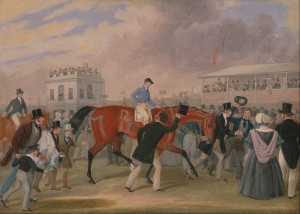 The Epsom Derby; painting by James Pollard, c. 1840
The Epsom Derby; painting by James Pollard, c. 1840
The conditioning program for the different horses varies depending on the race length. Genetics, training, age, and skeletal soundness are all factors that contribute to a horse’s performance. The muscle structure and fiber type of horses depends on the breed, therefore genetics must be considered when constructing a conditioning plan. A horse’s fitness plan must be coordinated properly in order to prevent injury or unnecessary lameness. If these were to occur, they may negatively affect a horse’s willingness to learn. Sprinting exercises are appropriate for training two-year-old racehorses, but they are mentally incapable of handling too many of them. A horse’s skeletal system adapts to the exercise they are receiving. Because the skeletal system does not reach full maturity until the horse is at least four years of age, young racehorses often suffer multiple injuries.
Horse racing by country
North America – Horse racing in the United States
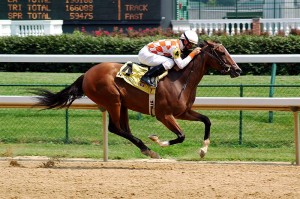 Race at Churchill Downs
Race at Churchill Downs
Horse racing in the United States and on the North American continent dates back to 1665, which saw the establishment of the Newmarket course in Salisbury, New York, a section of what is now known as the Hempstead Plains of Long Island, New York. This first racing meet in North America was supervised by New York’s colonial governor, Richard Nicolls. The area is now occupied by the present Nassau County, New York, region of Greater Westbury and East Garden City. The South Westbury section is also (appropriately) known as Salisbury.
In the United States, Thoroughbred flat races are run on surfaces of either dirt, synthetic or turf. Other tracks offer Quarter Horse racing and Standardbred horse racing, or combinations of these three types of racing surfaces. Racing of other breeds, such as Arabian horse racing, is found on a limited basis. American Thoroughbred races are run at a wide variety of distances, most commonly from 5 to 12 furlongs (0.63 to 1.50 mi; 1.0 to 2.4 km); with this in mind, breeders of Thoroughbred race horses attempt to breed horses that excel at a particular distance (see Dosage Index).
The Pleasanton Fairgrounds Racetrack at the Alameda County Fairgrounds is the oldest horse racing track in America, dating back to 1858, when it was founded by the sons of the Spaniard Don Agustin Bernal.
In 1665, the first racetrack was constructed on Long Island. It is the oldest Thoroughbred race in North America. The American Stud Book was started in 1868, prompting the beginning of organized horse racing in the United States. There were 314 tracks operating in the United States by 1890; and in 1894, the American Jockey Club was formed.
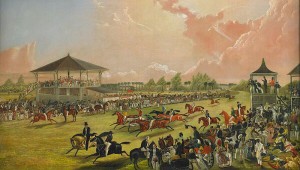 Horse racing at Jacksonville, Alabama, 1841
Horse racing at Jacksonville, Alabama, 1841
The first record of quarter mile length races dated back to 1674 in Henrico County, Virginia. Each race consisted of only two horses and they raced down the village streets and lanes. The Quarter Horse received its name due to the length of the race. The races were indeed “a quarter” of a mile, or 400 meters. The breed of horse was developed so they could get off to a quick start, and win the race.
Belmont Park is part of the western edge of the Hempstead Plains. Its mile-and-a-half main track is the largest dirt Thoroughbred race course in the world, and it has the sport’s largest grandstand.
One of the latest major horse track opened in the United States was the Meadowlands Racetrack opened in 1977 for Thoroughbred racing. It is the home of the Meadowlands Cup. Other more recently opened tracks include Remington Park,Oklahoma City, opened in 1988, and Lone Star Park in the Dallas–Fort Worth Metroplex, opened in 1997; the latter track hosted the prestigious Breeders’ Cup series of races in 2004.
Thoroughbred horse racing in the United States has its own Hall of Fame in Saratoga Springs, New York. The Hall of Fame honors remarkable horses, jockeys, owners, and trainers.
The traditional high point of US horse racing is the Kentucky Derby, held on the first Saturday of May at Churchill Downs in Louisville, Kentucky. Together, the Derby; the Preakness Stakes, held two weeks later at Pimlico Race Course in Baltimore, Maryland; and the Belmont Stakes, held three weeks after the Preakness at Belmont Park on Long Island, form the Triple Crown of Thoroughbred Racing for three-year-olds. They are all held early in the year, throughout May and the beginning of June. In recent years the Breeders’ Cup races, run at the end of the year, have challenged the Triple Crown events as determiners of the three-year-old Champion. The Breeders’ Cup is normally held at a different track every year; however the 2010 and 2011 editions were held at Churchill Downs, and the 2012 and 2013 races were held at Santa Anita Park, as will the 2014 edition.
The corresponding Standardbred event is the Breeders’ Crown. There are also a Triple Crown of Harness Racing for Pacers and a Triple Crown of Harness Racing for Trotters, as well as an Arabian Triple Crown consisting of Drinkers of the Wind Derby in California, the Texas Six Shooter Stakes, and the Bob Magness Derby in Delaware.
American betting on horse racing is sanctioned and regulated by the state the racetrack is located in. Simulcast betting exists across state lines with minimal oversight except the companies involved through legalized parimutuel gambling. A takeout, or “take,” is removed from each betting pool and distributed according to state law, among the state, race track and horsemen. A variety of factors affect takeout, namely location and the type of wager that is placed.
Canada
The most famous horse from Canada is generally considered to be Northern Dancer, who after winning the Kentucky Derby, Preakness and Queen’s Plate in 1964 went on to become the most successful Thoroughbred sire of the 20th century; his two-minute-flat Derby was the fastest on record until Secretariat in 1973. The only challenger to his title of greatest Canadian horse would be his son Nijinsky II, who is the last horse to win the English Triple Crown. Woodbine Racetrack(1956) in Toronto, home of the Queen’s Plate (1860), Canada’s premier Thoroughbred stakes race, and the North America Cup (1984), Canada’s premier Standardbred stakes race, is the only race track in North America which stages Thoroughbred and Standardbred (harness) meetings on the same day. The Pattison Canadian International has the largest purse of any Canadian horse race. Other key races include Woodbine Oaks (1956), Prince of Wales Stakes (1929), Breeders’ Stakes (1889) and Canadian Derby (1930).
Europe
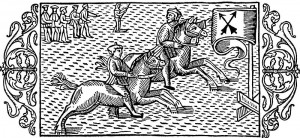 Horse racing in Sweden, c. 1555
Horse racing in Sweden, c. 1555
Belgium
Horse racing in Belgium takes place at three venues – Hippodrome Wellington in Ostend (opened in 1883 in honour of Arthur Wellesley, 1st Duke of Wellington), Hippodroom Waregem in Waregem in Flanders and Hippodrome de Wallonie in Mons, Wallonia.
Czech Republic
There are 15 racecourses in the Czech Republic, most notably Pardubice Racecourse, where the country’s most famous race, the Velka Pardubicka steeplechase has been run since 1874. Since 1907 races have also held on a central racecourse in Prague – Velka Chuchle. However, the first official race was organized back in 1816 by Emperor Francis II near Kladruby nad Labem. The Czech horse racing season usually starts at the beginning of April and ends some time in November. Racing takes place mostly at weekends and there is usually one meeting on a Saturday and one on Sunday. Horse races, as well as thoroughbred horse breeding, is organized by Jockey Club Czech Republic, founded in 1919.
List of French flat horse races, Category:Horse racing in France and French flat racing Champion Jockey
France has one of the major horse racing industries in Europe. It is home to the famous Prix de l’Arc de Triomphe held at Longchamp Racecourse, the richest race in Europe and the second richest turf race in the world after the Japan Cup, with a prize of 4 million Euro (approx US$5.2 million). Other major races include the Grand Prix de Paris, the Prix du Jockey Club (the French Derby) and the Prix de Diane. Besides Longchamp, France’s other premier flat racecourses include Chantilly and Deauville. There is also a smaller, but nevertheless important jumps racing sector, with Auteil Racecourse being the most well known. The sport’s governing body is France Galop
Horseracing in Scotland and Horseracing in Wales
Horse racing in Great Britain is predominantly thoroughbred flat and jumps racing. It was in Great Britain in the 17th to 19th centuries that many of the sport’s rules and regulations were established. Many of the sport’s greatest jockeys, most notably Sir Gordon Richards have been British. The sport is regulated by the British Horseracing Authority. Note that the BHA’s authority does not extend to Northern Ireland — racing in Ireland is governed on an All-Ireland basis.
Hungary
Hungary has a long standing horse racing tradition. The first horse racing in Pest was noted 6 June 1827. Although racing in Hungary is neither as popular, nor as prestigious as it is in Western Europe, the country is notable for producing some fine international racehorses. Foremost of these is Kincsem, foaled in 1874, and the most successful Thoroughbred race horse ever, having won 54 races for 54 starts. More recently, the country produced Overdose, a horse who won his first 12 races, including Group races in Germany and Italy, and finished fourth in the King’s Stand Stakes at Royal Ascot.
Ireland has a rich history of horse racing; point to pointing originated there and even today, (jump racing) is more popular than racing on the flat. As a result, every year Irish horse racing fans travel in huge numbers to the highlight event of the National Hunt calendar, the Cheltenham Festival, and in recent years Irish owned or bred horses have dominated the event. Ireland has a thriving Thoroughbred breeding industry, stimulated by favourable tax treatment. The world’s largest Thoroughbred stud, Coolmore Stud, has its main farm there (in addition to major operations in the U.S. and Australia).
In recent years, Irish bred and trained horses have enjoyed considerable success in major races worldwide. Various horses achieved victory in one or more of the British 2000 Guineas, the Epsom Derby and the Prix de l’Arc de Triomphe, considered the three most prestigious races in Europe. In the 6 runnings of the Epsom Derby between 2008 and 2013, Irish horses filled 20 of the first 30 placings, winning the race 5 times.
Historically, Italy has been one of the leading European horse racing nations, albeit some way behind Great Britain, Ireland and France in size and prestige. The late Italian horse breeder Federico Tesio is one of the towering figures of the Thoroughbred breeding industry. In recent years, however, the sport in the country has suffered a major funding crisis, culminating in its expulsion from the European Pattern.
Although of little consequence in the wider horse racing world, a popular Italian race is the Palio di Siena (known locally as Il Palio), the most famous palio in Italy, a horse race held twice each year on July 2 and August 16 in Siena, in which the horse and rider represent one of the seventeen Contrade, or city wards. A magnificent pageant precedes the race, which attracts visitors and spectators from around the world.
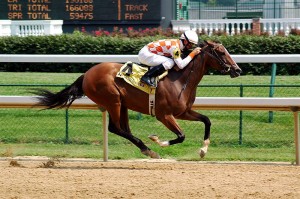 Eclipse an undefeated British racehorse and outstanding sire.
Eclipse an undefeated British racehorse and outstanding sire.
Netherlands
In Wassenaar in the Hague there is a grass course at Duindigt.
Poland
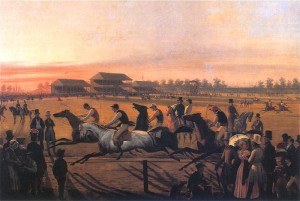 “First regular horse racing on Pola Mokotowskie in Warsaw” January Suchodolski 1849.
“First regular horse racing on Pola Mokotowskie in Warsaw” January Suchodolski 1849.
Horse racing in Poland can be dated to 1777 when a horse owned by Polish noble Kazimierz Rzewuski beat the horse of the English chargé d’affaires, Sir Charles Whitworth on the road from Wola to Ujazdów Castle. The first regular horse racing was organized in 1841 on Mokotów Fields in Warsaw by Towarzystwo Wyścigów Konnych i Wystawy Zwierząt Gospodarskich w Królestwie Polskim (in English, the Society of Horse Racing in Congress Poland). The major racetrack in Poland is Warsaw’s Służewiec Racecourse. The industry was severely limited during the Communist era, when gambling, the major source of funding, was made illegal.
Oceania – Thoroughbred racing in Australia and Harness racing in Australia
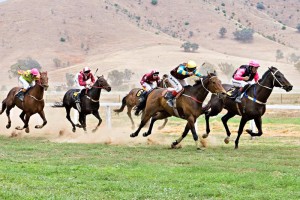 Tambo Valley Picnic Races, Victoria, Australia 2006
Tambo Valley Picnic Races, Victoria, Australia 2006
Horse racing in Australia was founded during the early years of settlement and the industry has grown to be among the top three leading Thoroughbred racing nations of the world. The world famous Melbourne Cup, the race that stops a nation, has recently attracted many international entries. In country racing, records indicate that Goulburn commenced racing in 1834. Australia’s first country racing club was established at Wallabadah in 1852 and the Wallabadah Cup is still held on New Year’s Day (the current racecourse was built in 1898).
In Australia, the most famous racehorse was Phar Lap (bred in New Zealand), who raced from 1928 to 1932. Phar Lap carried 9 st 12 lb (62.5 kg) to win the 1930 Melbourne Cup. Australian steeplechaser Crisp is remembered for his battle with Irish champion Red Rum in the 1973 Grand National. In 2003–2005 the mare Makybe Diva (bred in Great Britain) became the only racehorse to ever win the Melbourne Cup three times, let alone in consecutive years. In harness racing, Cane Smoke had 120 wins, including 34 in a single season, Paleface Adios became a household name during the 1970s, while Cardigan Bay, a pacing horse from New Zealand, enjoyed great success at the highest levels of American harness racing in the 1960s. More recently, Blacks A Fake has won four Inter Dominion Championships, making him the only horse to complete this feat in Australasia’s premier harness race.
Competitive endurance riding commenced in Australia in 1966, when the Tom Quilty Gold Cup was first held in the Hawkesbury district, near Sydney, New South Wales. The Quilty Cup is considered the National endurance ride and there are now over 100 endurance events contested across Australia, ranging in distances from 80 km to 400 km. The world’s longest endurance ride is the Shahzada 400 km Memorial Test which is conducted over five days travelling 80 kilometres a day at St Albans on the Hawkesbury River, New South Wales. In all endurance events there are rigorous vet checks, conducted before, during and after the competition, in which the horses’ welfare is of the utmost concern.
Thoroughbred racing in New Zealand and Harness racing in New Zealand
Racing is a long-established sport in New Zealand, stretching back to colonial times.
Horse racing is a significant part of the New Zealand economy which in 2004 generated 1.3% of the GDP. The indirect impact of expenditures on racing was estimated to have generated more than $1.4 billion in economic activity in 2004 and created 18,300 full-time equivalent jobs. More than 40,000 people were involved in some capacity in the New Zealand racing industry in 2004. In 2004, more than one million people attended race meetings in New Zealand. There are 69 Thoroughbred and 51 harness clubs licensed in New Zealand. Racecourses are situated in 59 locations throughout New Zealand.
The bloodstock industry is important to New Zealand, with the export sale of horses – mainly to Australia and Asia – generating more than $120 million a year. During the 2008–09 racing season 19 New Zealand bred horses won 22 Group One races around the world.
Notable racehorses from New Zealand include Cardigan Bay, Carbine, Nightmarch, Sunline, Desert Gold and Rising Fast. Phar Lap and Tulloch were both bred in New Zealand but did not race there. The most famous of these is probably Cardigan Bay. Stanley Dancer drove the New Zealand bred horse, Cardigan Bay to win $1 million in stakes in 1968, the first harness horse to surpass that milestone in American history.

